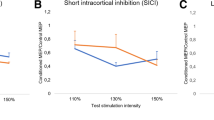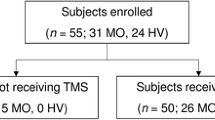Abstract
We previously showed paradoxical facilitatory effects of low-frequency repetitive transcranial magnetic stimulation (rTMS) on striate and extrastriate cortex of patients suffering migraine with aura. In this study we evaluated the effects of 1 Hz rTMS on the excitability of inhibitory and facilitatory circuits of motor cortex to explore whether the abnormal pattern of excitability extends beyond the sensory cortex also involving motor areas in migraine with aura. Nine patients affected by migraine with aura and eight healthy controls entered into the study. The hot spot for activation of the right abductor pollicis brevis (APB) was checked by means of a figure-of-eight coil and motor threshold (MT) recorded on this point. Nine hundred magnetic stimuli at 1 Hz frequency and 90% MT intensity were delivered at the hot spot. Before and after rTMS, intracortical inhibitory and facilitatory circuit excitability was assessed by means of a paired pulse paradigm (conditioning stimulus 80% MT and test stimulus 120% MT) with two different interstimulus intervals: 2 ms (inhibitory) and 10 ms (facilitatory). Amplitude of the responses was expressed as the percentage of motor evoked potential (MEP) to test stimulus alone. Results showed that in basal condition migraineurs present significantly reduced levels of intracortical inhibition (ICI) compared to controls. More importantly, opposite results were obtained in migraineurs with respect to controls when 1 Hz rTMS was applied. Specifically, whereas intracortical facilitation (ICF) significantly decreased in controls, it significantly increased in migraineurs. ICI levels were not significantly affected by low-frequency stimulation. Our results showed that motor as well as sensory cortex of migraine patients present an abnormal modulation of cortical excitability, where a relevant role is likely played by the inefficiency of inhibitory circuits.



Similar content being viewed by others
References
Afra J, Mascia A, Gèrard P, Maertens de Noordhout A, Schoenen J (1998) Interictal cortical excitability in migraine: a study using transcranial magnetic stimulation of motor and visual cortices. Ann Neurol 44:209–215
Aurora SK, Ahmad BK, Welch KMA, Bhardhwaj P, Ramadan NM (1998) Transcranial magnetic stimulation confirms the hyperexcitability of occipital cortex in migraine. Neurology 50:1111–1114
Aurora SK, al-Sayeed F, Welch KM (1999) The cortical silent period is shortened in migraine with aura. Cephalalgia 19:708–712
Boroojerdi B, Prager A., Muellbacher W, Cohen LG (2000) Reduction of human visual cortical excitability using low transcranial magnetic stimulation. Neurology 54:1529–1531
Brighina F, Piazza A, Daniele O, Fierro B (2002) Modulation of visual cortex excitability in migraine with aura: effects of 1 Hz repetitive transcranial magnetic stimulation. Exp Brain Res 145:177–181
Chen R, Classen J, Gerloff C, Celnik P, Wassermann EM, Hallett M, Cohen LG (1997) Depression of motor cortex excitability by low-frequency transcranial magnetic stimulation. Neurology 48:1398–1403
Di Lazzaro V, Restuccia D, Olivero A, Proficue P, Ferrara L, Insola A, Mazzone P, Tonali P, Rothwell JC (1998) Magnetic transcranial stimulation at intensities below active motor threshold activates intracortical inhibitory circuits. Exp Brain Res 119:265–268
Fierro B, Ricci R, Piazza A, Scalia S, Giglia G, Vitello G, Brighina F (2003) 1 Hz rTMS enhances extrastriate cortex activity in migraine. Evidence of reduced inhibition? Neurology 61:1446–1448
Fitzgerald PB, Brown TL, Daskalakis ZJ, Chen R, Kulkarni J (2002) Intensity-dependent effects of 1 Hz rTMS on human corticospinal excitability. Clin Neurophysiol 113:1136–1141
Headache Classification Subcommittee of the International Headache Society (2004) The International Classification of Headache Disorders, 2nd edn. Cephalalgia 24 [Suppl 1]:9–160
Hess G, Donoghue JP (1994) Long-term potentiation of horizontal connections provides a mechanism to reorganize cortical motor maps. J Neurophysiol 71:2543–2547
Kujirai T, Caramia MD, Rothwell JC, Day BL, Thompson PD, Ferbert A, Wroe S, Asselman P, Marsden CD (1993) Corticocortical inhibition in human motor cortex. J Physiol 471:501–519
Maeda F, Keenan JP, Tormos JM, Topka H, Pascual-Leone A (2000) Interindividual variability of the modulatory effects of repetitive transcranial magnetic stimulation on cortical excitability. Exp Brain Res 133:425–430
McCormick DA (1989) GABA as an inhibitory neurotransmitter in human cerebral cortex. J Neurophysiol 62:1018–1027
Maertens de Noordhout A, Pepin JL, Schoenen J, Delwaide PJ (1992) Percutaneous magnetic stimulation of the motor cortex in migraine. Electroencephalogr Clin Neurophysiol 85:110–115
Mulleners WM, Chronicle EP, Palmer JE, Koehler PJ, Vredeveld JW (2001a) Visual cortex excitability in migraine with and without aura. Headache 41:565–572
Mulleners WM, Chronicle EP, Palmer JE, Koehler PJ, Vredeveld JW (2001b) Suppression of perception in migraine: evidence for reduced inhibition in visual cortex. Neurology 56:178–183
Palmer JE, Chronicle EP, Rolan P, Mulleners WM (2000) Cortical hyperexcitability is cortical under-inhibition: evidence from a novel functional test of migraine patients. Cephalalgia 20:525–532
Pascual-Leone A, Valls-Sole J, Wassermann EM, Hallett M (1994) Responses to rapid-rate transcranial magnetic stimulation of the human motor cortex. Brain 117:847–858
Romero JR, Anschel D, Sparing R, Gangitano M, Pascual-Leone A (2002) Subthreshold low frequency repetitive transcranial magnetic stimulation selectively decreases facilitation in the motor cortex. Clin Neurophysiol 113:101–107
Rothwell JC (1996) The use of paired pulse stimulation to investigate the intrinsic circuitry of human motor cortex. In: Nilsson J, Panizza M, Grandori F (eds) Advances in magnetic stimulation. Mathematical modeling and clinical applications. Fondazione Salvatore Maugeri, Pavia, Italy, pp 99–104
Schwenkreis P, Liepert J, Witscher K, Fischer W, Weiller C, Malin JP, Tegenthoff M (2000) Riluzole suppresses motor cortex facilitation in correlation to its plasma level. A study using transcranial magnetic stimulation. Exp Brain Res 135:293–299
Siebner HR, Tormos JM, Ceballos-Baumann AO, Auer C, Catala MD, Conrad B, Pascual-Leone A (1999) Low-frequency repetitive transcranial magnetic stimulation of the motor cortex in writer’s cramp. Neurology 52:529–537
Siebner HR, Mentschel C, Auer C, Lehner C, Conrad B (2000). Repetitive transcranial magnetic stimulation causes a short-term increase in the duration of the cortical silent period in patients with Parkinson’s disease. Neurosci Lett 284:147–150
Touge T, Gerschlager W, Brown P, Rothwell JC (2001) Are the after-effects of low-frequency rTMS on motor cortex excitability due to changes in the efficacy of cortical synapses? Clin Neurophysiol 112:2138–2145
van der Kamp W, Maassen Van Den Brink A, Ferrari MD, van Dijk JG (1996) Interictal cortical hyperexcitability in migraine patients demonstrated with transcranial magnetic stimulation. J Neurol Sci139:106–110
van der Kamp W, Maassen Van Den Brink A, Ferrari MD, van Dijk JG (1997) Interictal cortical excitability to magnetic stimulation in familial hemiplegic migraine. Neurology 48:1462–1464
Ziemann U (1999) Intracortical inhibition and facilitation in the conventional paired TMS paradigm. Electroencephalogr Clin Neurophysiol 51 [Suppl]:127–136
Ziemann U, Corwell B, Cohen LG (1998) Modulation of plasticity in human motor cortex after forearm ischemic nerve block. J Neurosci 18:1115–1123
Ziemann U, Lonnecker S, Paulus W (1995) Inhibition of human motor cortex by ethanol. A transcranial magnetic stimulation study. Brain 118:1437–1446
Ziemann U, Rothwell JC, Ridding MC (1996) Interaction between intracortical inhibition and facilitation in human motor cortex. J Physiol 496:873–881
Acknowledgements
We thank J. Lima and C. Finocchiaro for correction and improvement of the language.
Author information
Authors and Affiliations
Corresponding author
Rights and permissions
About this article
Cite this article
Brighina, F., Giglia, G., Scalia, S. et al. Facilitatory effects of 1 Hz rTMS in motor cortex of patients affected by migraine with aura. Exp Brain Res 161, 34–38 (2005). https://doi.org/10.1007/s00221-004-2042-7
Received:
Accepted:
Published:
Issue Date:
DOI: https://doi.org/10.1007/s00221-004-2042-7




